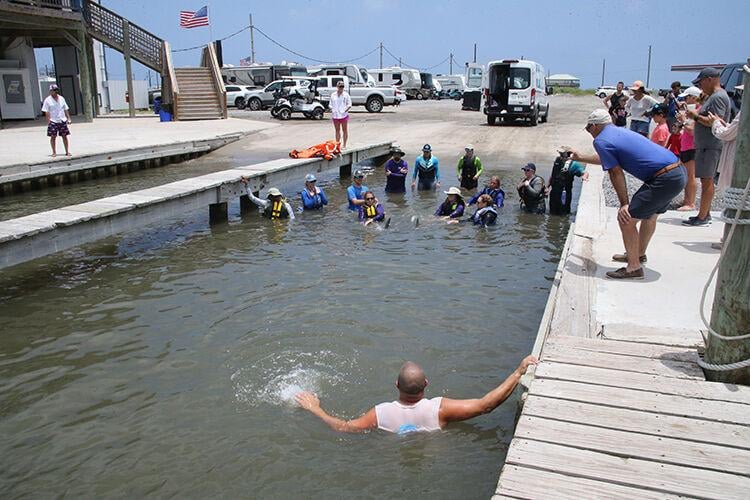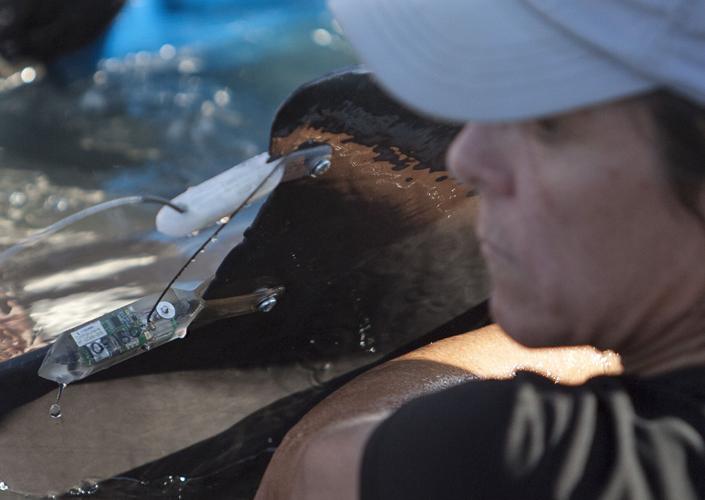It took a team of nearly 30 trained personnel using specially equipped boats and a van to humanely capture and relocate a mother and baby bottlenose dolphin from a tidal pond near Grand Isle to open water this past June.
The complex operation had a simple goal: Setting the pair of dolphins free from the enclosed pond, where they’d been stranded for nearly two years due to storm surge and flooding during Hurricane Ida in August 2021. Neither was facing health problems.
It also was a rare positive ending to one of the 27 marine mammal strandings responded to in Louisiana this year, funded by part of $3 million in BP Deepwater Horizon oil spill natural resource damage restoration funds.
“Each dolphin stranding or out-of-habitat response is different,” said Melissa Lee, a spokesperson for the Audubon Nature Institute’s Coastal Wildlife Network, which responds to dolphin and sea turtle strandings. "In the case of the mother and calf, teams had monitored them for nearly two years as they had ample food and were not in immediate danger.”

Locations of bottlenose dolphins during March and April 2019 photo-identification surveys. Each black dot represents 1-30 dolphins. The blue "heat map" color shows where the most dolphins were seen. Note that the area labeled central will see the lowest salinity levels when the Mid-Barataria Sediment Diversion is operating. (Army Corps of Engineers, NOAA)
But this year's rescues are also part of a broader strategy to ramp up the response network before the opening of Louisiana's largest-ever coastal restoration project, the nearly $3 billion Mid-Barataria Sediment Diversion. Groundbreaking for the project is scheduled for Thursday, but it won't begin operating until late 2027 or early 2028.
The freshwater from the Mississippi River delivered to the Barataria Basin for several months each year by the diversion is predicted to result in a 10-fold increase in dolphin deaths in its first year, and to make three groups of dolphins "functionally extinct" in the Barataria Basin in the diversion's first 10 years of operation.
The diversion will deliver sediment and freshwater at rates that could reach a maximum of 75,000 cubic feet per second during major river flood years — the equivalent of more than 560,000 gallons per second. It will operate when the river flow adjacent to the diversion, just north of the town of Ironton, reaches 450,000 cfs, which is likely to occur for several months each year. When water flows drop below that amount, the diversion will still deliver up to 5,000 cfs into the basin to keep its outfall area free of sediment.
When operating, salinity levels in the upper basin and in a pathway reaching nearly to Grand Isle will drop to near zero. But for the state, the sediment being infused into the basin is worth the trade-off since it will help slow land loss devastating Louisiana's coast.

Photos of skin lesions on individual dolphins surveyed in Lake Pontchartrain in 2010. Most of the dolphins in these photos died. (NOAA)
Dolphins exposed to water with very low salt suffer from lesions, in some cases so bad their skin just sloughs off, and can become overgrown with mats of fungi, algae and bacteria. Ingestion of freshwater while feeding also can cause illnesses, according to an environmental impact statement by the Army Corps of Engineers.
Modeling “predicts 537 more dolphin deaths as a result of the diversion in the first year of operations than would be predicted to occur without the diversion,” a NOAA spokesperson said, though that number could fluctuate. The 537 deaths represent about 26% of the dolphins that were living in the basin in 2019.

Biologists and researchers surround two male dolphins with nets and once corralled, swimmers jump in to keep the mammal calm during a research study trip in Barataria Bay, Monday August 15, 2011. (Archive photo by Ted Jackson, The Times-Picayune)
Barataria dolphins live in four areas, labeled by scientists as western, central, southeast, and barrier islands, which includes the area near Grand Isle and Grand Terre. The central area is likely to see the lowest salinity levels for the longest time, and also seems to have the largest number of dolphins most of the year, studies show. Second in low salinity levels is the western area.
The model cited by the environmental statement “projects that dolphins in the western and central strata would be functionally extinct (defined as less than or equal to 1 within 10 years), and the dolphins in the southeast stratum would be functionally extinct within 50 years.” The number of dolphins living near the barrier islands would drop, but not by as great a percentage, since the amount of freshwater in that area is expected to be lower.
All areas except the barrier islands likely were not home to dolphins at the turn of the 20th century, before the loss of 2,000 square miles of wetlands along the state’s coastline. That allowed the dolphins to feed along the edges of the eroding wetlands much farther inland. Dolphins tend to stay within areas in which they grew up and return there when relocated.

Biologists and researchers surround a pregnant female dolphin with nets and then try to keep the mammal calm before conducting tests during a research study trip in Barataria Bay, Monday August 15, 2011. (Archive photo by Ted Jackson, The Times-Picayune)
The environmental impact statement agrees with state officials’ conclusions that the expected 21 square miles of new land created during the diversion's first 50 years of operation will outweigh the dolphin deaths. But it took an act of Congress to overrule a potential veto of the diversion’s construction by the federal Marine Mammal Protection Act.

Scientists check a male dolphin's teeth while they conduct tests and take samples during a research study trip in Barataria Bay, Monday August 15, 2011. (Archive photo by Ted Jackson, The Times-Picayune)
However, the law also requires Louisiana “to the extent practicable and consistent with the purpose of the project, to minimize impacts on marine mammal species and population stocks and monitor and evaluate the impacts of the project on such species and population stocks.”
The trustees who oversee the BP spill dollars approved $2.26 billion for construction of the diversion, including $378 million to mitigate its effects. The National Fish and Wildlife Foundation has also made available $660 million for construction and design, from criminal fines paid by BP and Transocean for the 2010 spill.

Scientists attach a satellite radio tag to the dorsal fin before releasing a dolphin during a research study trip in Barataria Bay, Monday August 15, 2011. (Archive photo by Ted Jackson, The Times-Picayune)
According to a NOAA spokesperson, mitigation funding includes $20 million for potential intervention for injured or sick dolphins and to deal with dead dolphins. It also includes $40 million for monitoring and stewardship of all affected natural resources.

Scientists brand a male dolphin with frozen branding iron before releasing him during a research study trip in Barataria Bay, Monday August 15, 2011. (Archive photo by Ted Jackson, The Times-Picayune)
The “dolphin response team” called for by the trustees is in part based on concerns identified in a series of historic numbers of deaths of dolphins and whales in the Gulf in the 1990s, linked to infections.
Between 2010 and 2014, more than 1,150 cetaceans — dolphins and whales — were killed, both just before and after the BP oil spill, from a variety of illnesses, with many linked to exposure to the BP oil.

This map shows the locations of mostly dead dolphins stranded in 2019 along the central Gulf Coast. Most were victims of freshwater illnesses caused by a combination of rainfall events along the coast and the 121-day opening of the Bonnet Carre Spillway that funneled Midwest rainfall that caused a high Mississipppi River to Lake Pontchartran and the Mississippi Sound. (NOAA)
Between February and November 2019, 337 bottlenose dolphins were stranded along the Gulf Coast, most in Louisiana and Mississippi, including nine found alive. That was tied to exposure to low salinity levels caused by repeated rain along the shore and the release of Mississippi River water through the Bonnet Carre Spillway. The spillway was opened twice that year, for a total of 121 days, due to unusually high river levels.
The project environmental impact statement also cited a study of as many as 40 dolphin deaths in Lake Pontchartrain in 2010 tied to both freshwater exposure and cold temperatures. They had been living in the lake since possibly entering it to escape storm surge during Hurricane Katrina in 2005. The Bonnet Carre diversion was opened for 31 days in 2008, which also increased freshwater in the normally brackish lake.
Lisa Belskis, spokesperson for the NOAA Southeast Fisheries Science Center, which conducted the study, said the effect on dolphins "would depend on the level of salinity and for how long it occurred."

Veterinarians collect a urine sample from Y12, a 16-year-old adult male bottlenose dolphin caught near Grand Isle in August 2011. Y12’s health evaluation determined that he was significantly underweight, anemic, and had indications of liver and lung disease. After the evaluation and attachment of VHF and satellite-linked tags, Y12 was released. (NOAA)
Plans to keep as many dolphins alive as possible will be divided into three phases.
- The first, lasting as much as 24 months during the diversion's construction, will include workshops on dolphin health, low salinity exposure, hydrology in the basin, and biology. Experts will evaluate potential intervention strategies ranging from remote monitoring to hands-on capture, rehabilitation and release or relocation, and euthanasia. The experts will help draft plans to triage dolphin exposure cases to identify animals most likely to survive.
- The second, likely to include the period just before the diversion operates to the first year or two after completion, will include study of dolphins in the basin.
- The final phase, to include the first years when the diversion is operating and lengthy exposure to low salinity is likely, will include interventions based on previous findings and training.

A team of volunteers forms a line to "haze" a dolphin to keep it from entering a freshwater canal in Florida. (Clearwater Marine Aquarium)
The response team will conduct sampling from floating feces, dolphin breath using pole-based or drone-based monitors, and skin, blubber and blood collected from darts.
In some cases, responders might attempt to herd, haze or deter dolphins away from the lowest salinity areas, using percussive slapping from vessels including paddleboards, kayaks and Jet Skis. Pingers, or other acoustic devices, including scuba diver recall sirens, might also be used.

Scientists and volunteers use a seine net to encircle a dolphin to allow it to be tested and tagged. (NOAA Marine Mammal Health and Stranding Response Program)
In some cases, capture may be warranted for a life-threatening condition where the dolphin is not likely to survive in its current location. Once captured, a dolphin will be examined and may receive treatment, and then will likely be marked and tagged for future identification. Euthanasia decisions will be determined by a veterinarian.
State Coastal Protection and Restoration Authority officials said they also plan on looking at other alternatives aimed at reducing the effects of freshwater on the dolphins, including designing future wetland restoration projects in ways that might funnel freshwater from the diversion away from some dolphin locations, or building berms to do the same thing.















